
The EU’s Committee of the Regions (CoR) will put a citizen from the bloc’s outermost regions at the helm of an EU institution – a historic first.
Some EU member states have parts of their territory located in areas of the world that are far removed from the European continent. These far-flung areas, known as outermost regions (ORs), are often an afterthought in EU policymaking at best.
The new president of the regional body, Vasco Alves Cordeiro, who will be elected on Wednesday for a two-and-a-half-year term, may change that. Cordeiro hails from the Azores, a Portuguese archipelago in the mid-Atlantic which is one of the EU’s nine ORs.
“The Azores is the place I come from, it’s the people and the region I served as President of the Government and I still have the honour to serve in the Parliament,” he told EURACTIV.
“This is the reason why I am member of the Committee of the Regions, the political assembly of local and regional authorities, and it’s the reason why I believe all regions and cities must equally contribute to building the future of Europe.”
While the Azores are one of the EU’s wealthier ORs, with a GDP per capita of around 90% of the bloc’s average, having one of the island’s 240,000 inhabitants leading the CoR could prove beneficial in bringing attention to the regions.
“Our outermost regions may be distant from the European mainland, but they are very important for the EU,” Executive Vice-President of the European Commission Valdis Dombrovskis said in May as he represented the Commission’s renewed strategy for the ORs.
The regions face unique challenges, with some of the EU’s highest unemployment rates and lowest GDPs. The COVID-19 pandemic brought further difficulties, given that most are reliant on long-distance travel in order to be connected to the European mainland.
“To bridge the gap in quality of life between the outermost regions and the rest of the EU,” Cohesion Commissioner Elisa Ferreira said in May, the new strategy will “develop dedicated opportunities for them” and provide tailored support. The General Affairs Council approved the strategy on 21 June.
In the EU’s last long-term budget, the outermost regions received close to €14 billion in structural support, a number that will likely be exceeded by the 2021-2027 budget. One quirk: the ORs are the only regions allowed to spend EU structural funds on airports.
With a new strategy and representation at the very top of an EU institution, things may now be looking up for the outermost regions, for once.
Jostling for influence
For the Committee of Regions – whose members are, as is often emphasised, democratically elected – jostling for additional influence is a Sisyphean task.
While Cordeiro’s presidential priorities will be formally presented on Wednesday (29 June), one will be to “strengthen” the role of the CoR, according to sources familiar with the matter.
In a decade that looks set for EU reform following the Conference on the Future of Europe and a growing appetite to move away from unanimity in certain policy areas, Cordeiro seems poised to leap on the opportunity to bring the role of the CoR to the fore.
So far, the outgoing president of the regional body, Apostolis Tzitzikostas, has sought to align the institution with the conference, something the plenary of the CoR will affirm late on Wednesday.
Cordeiro met with most of the CoR’s representatives in March during the biannual regional summit held in Marseille and is likely assured of their backing. Should he be able to wrestle the regions into wholeheartedly supporting the green transition, something far from certain, he may be able to pave the way for additional influence for the institution.
Source: euractiv.com



